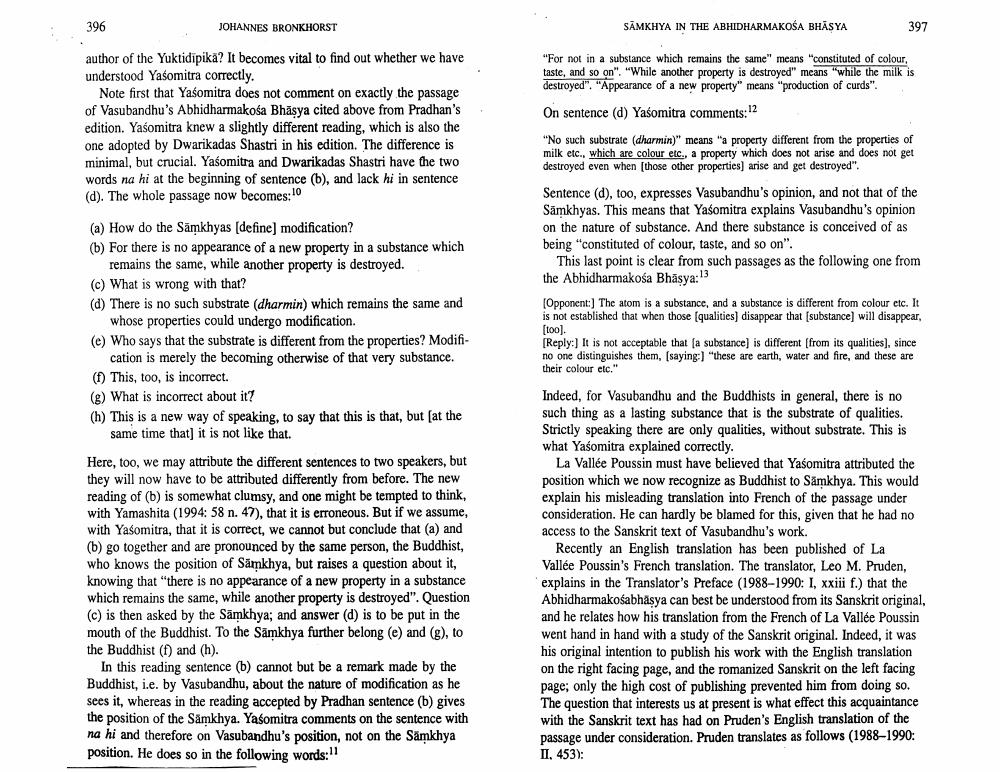________________
396
JOHANNES BRONKHORST
SAMKHYA IN THE ABHIDHARMAKOŚA BHĀSYA
397
"For not in a substance which remains the same means "constituted of colour, taste, and so on". "While another property is destroyed" means "while the milk is destroyed". "Appearance of a new property means "production of curds".
On sentence (d) Yaśomitra comments: 12
author of the Yuktidipika? It becomes vital to find out whether we have understood Yašomitra correctly.
Note first that Yasomitra does not comment on exactly the passage of Vasubandhu's Abhidharmakośa Bhāsya cited above from Pradhan's edition. Yašomitra knew a slightly different reading, which is also the one adopted by Dwarikadas Shastri in his edition. The difference is minimal, but crucial. Yašomitra and Dwarikadas Shastri have the two words na hi at the beginning of sentence (b), and lack hi in sentence (d). The whole passage now becomes:
"No such substrate (dharmin)" means "a property different from the properties of milk etc., which are colour etc., a property which does not arise and does not get destroyed even when those other properties) arise and get destroyed".
Sentence (d), too, expresses Vasubandhu's opinion, and not that of the Samkhyas. This means that Yasomitra explains Vasubandhu's opinion on the nature of substance. And there substance is conceived of as being constituted of colour, taste, and so on".
This last point is clear from such passages as the following one from the Abhidharmakośa Bhāsya:
(a) How do the Samkhyas (define) modification? (b) For there is no appearance of a new property in a substance which
remains the same, while another property is destroyed. (c) What is wrong with that? (d) There is no such substrate (dharmin) which remains the same and
whose properties could undergo modification. (e) Who says that the substrate is different from the properties? Modifi
cation is merely the becoming otherwise of that very substance. (f) This, too, is incorrect. (8) What is incorrect about it? (h) This is a new way of speaking, to say that this is that, but at the
same time that] it is not like that.
(Opponent:) The atom is a substance, and a substance is different from colour etc. It is not established that when those (qualities) disappear that (substance) will disappear, [too) [Reply:) It is not acceptable that (a substance) is different (from its qualities), since no one distinguishes them, (saying: "these are earth, water and fire, and these are their colour etc."
Here, too, we may attribute the different sentences to two speakers, but they will now have to be attributed differently from before. The new reading of (b) is somewhat clumsy, and one might be tempted to think, with Yamashita (1994: 58 n. 47), that it is erroneous. But if we assume, with Yasomitra, that it is correct, we cannot but conclude that (a) and (b) go together and are pronounced by the same person, the Buddhist, who knows the position of Samkhya, but raises a question about it, knowing that there is no appearance of a new property in a substance which remains the same, while another property is destroyed". Question (c) is then asked by the Samkhya; and answer (d) is to be put in the mouth of the Buddhist. To the Samkhya further belong (e) and (g), to the Buddhist (f) and (h).
In this reading sentence (b) cannot but be a remark made by the Buddhist, i.e. by Vasubandhu, about the nature of modification as he sees it, whereas in the reading accepted by Pradhan sentence (b) gives the position of the Samkhya. Yasomitra comments on the sentence with na hi and therefore on Vasubandhu's position, not on the Samkhya position. He does so in the following words:"1
Indeed, for Vasubandhu and the Buddhists in general, there is no such thing as a lasting substance that is the substrate of qualities. Strictly speaking there are only qualities, without substrate. This is what Yaśomitra explained correctly.
La Vallée Poussin must have believed that Yasomitra attributed the position which we now recognize as Buddhist to Samkhya. This would explain his misleading translation into French of the passage under consideration. He can hardly be blamed for this, given that he had no access to the Sanskrit text of Vasubandhu's work.
Recently an English translation has been published of La Vallée Poussin's French translation. The translator, Leo M. Pruden, explains in the Translator's Preface (1988-1990: I. xxiii f.) that the Abhidharmakośabhasya can best be understood from its Sanskrit original, and he relates how his translation from the French of La Vallée Poussin went hand in hand with a study of the Sanskrit original. Indeed, it was his original intention to publish his work with the English translation on the right facing page, and the romanized Sanskrit on the left facing page; only the high cost of publishing prevented him from doing so. The question that interests us at present is what effect this acquaintance with the Sanskrit text has had on Pruden's English translation of the passage under consideration. Pruden translates as follows (1988-1990: II, 453):




